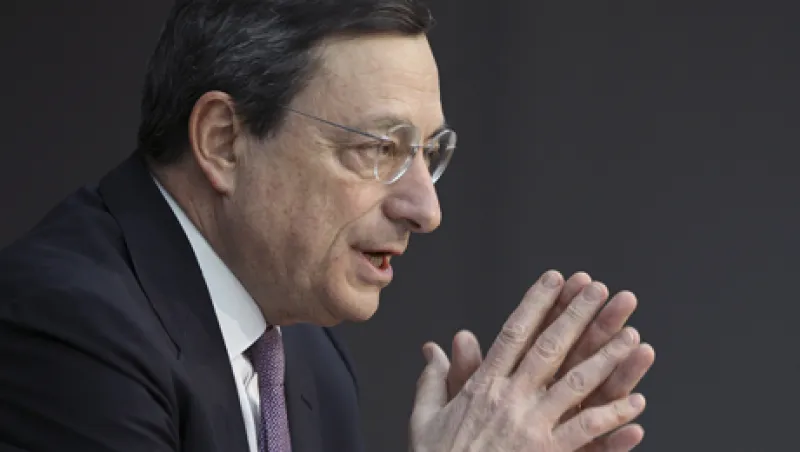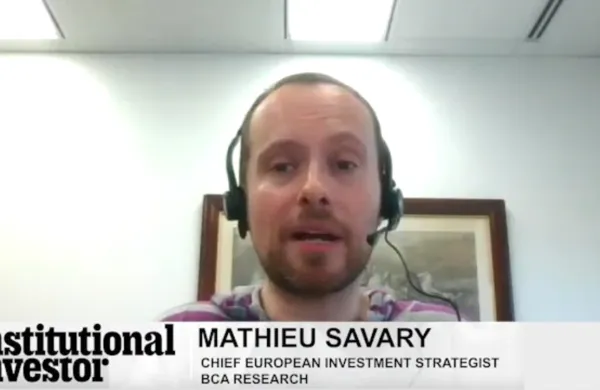The euro zone faces the risk of zero growth until at least 2014, according to a recent forecast by the European Central Bank (ECB) that underlines the fragility of the currency bloc’s economic recovery.
The ECB’s most pessimistic scenario for growth in gross domestic product suggests that the economy could shrink by 0.5 percent this year, and remain flat in 2013.
Thursday’s figures — which show a downgrading of expectations since the last ECB projections in December — underline the continuing risks to the region.
Explaining the downbeat assessment, ECB president Mario Draghi said “remaining tensions” in euro zone sovereign debt, combined with the paring of debt among banks and other companies, would “continue to dampen the underlying growth momentum.” He added, “Recovery is going to be very, very gradual.”
Draghi’s comments, made at a press conference following the ECB’s decision to leave its benchmark interest rate at 1 percent this month, came after a month of weak though not disastrous data from the euro zone. The data support the central bank president’s Thursday assessment that the region is experiencing “stabilization in economic activity, albeit still at a low level.”
February’s Purchasing Managers' Index for the region, published by Markit, indicates that January’s output growth — the first for four months — was simply a flash in the pan. The survey registered a rise in activity in Germany, France and Ireland, but a fall in output in peripheral euro zone countries, including Italy. Moreover, the latest official numbers show a rise in the euro zone unemployment rate to a record high of 10.7 percent. With joblessness becoming ever more widespread, households will be reluctant to boost economic demand through high spending.
The ECB’s growth figures of minus 0.5 percent in 2012 and zero percent in 2013 reflect the bottom range of its forecast. With an upper range of 0.3 percent this year and 2.2 percent next year, the mathematical midpoints of the forecast show a slight fall of only 0.1 percent in 2012, turning into growth of 1.1 percent in 2013. Draghi indicated, however, that growth is more likely to be nearer the bottom than the top of its forecast range by emphasizing that “this outlook remains subject to downside risks.” In particular, there was “a renewed intensification of tensions in euro area debt markets and their potential spillover to the euro area real economy,” with the possibility also of “further increases in commodity prices.”
Yields on Italian 10-year government bonds dropped a further 13 basis points on Thursday to 4.81 percent — far below the 7 percent-plus levels at which they traded when fears peaked late last year that Italy and other large euro zone economies would not be able to repay their debts. But 10-year rates in Portugal have recently risen, on fears it may follow Greece by partially defaulting on its debt. The yield on the benchmark bond closed on Thursday at 14.04 percent — 58 basis points higher than a month ago.
The commodity causing the most concern among euro zone leaders is oil, which has surged on fears that Middle Eastern supplies will be interrupted by the Iran crisis. The benchmark Brent price climbed another 1 percent to $125.30 on Thursday — up 10.9 percent on the year. A higher oil price will hit the euro zone economy by reducing consumers’ disposable income and businesses’ profit margins.
But despite his warnings, Draghi also pointed to several causes for hope, including the return of institutional and other investors to the region. “So-called real money investors have, to some extent, come back,” he said. “We see the presence of money market funds, which were the first to fly away from the euro a year and a half ago. We see, again, pension funds; we see investment funds.”
Draghi’s comments are borne out by the latest monthly survey of fund managers by Bank of America Merrill Lynch, which points to an extremely rapid improvement in investor sentiment. A net 5 percent of global investors said the euro zone was the region in which they would most like to be underweight — down from 29 percent the month before.
The ECB’s president also described the central bank’s two massive injections of liquidity into the banking system — its three-year long-term refinancing operations (LTROs) on December 21 and February 29 — as “an unquestionable success.” Many analysts agree with Draghi’s recent assessment that the first LTRO prevented a “major, major credit crunch” by restoring confidence in the solvency of euro zone banks.
Draghi, however, gave several clues that the February 29 LTRO will be the last ECB initiative for a while to prop up the euro zone economy. He argued that in its wake, “the ball is in the governments’ and the other actors’ — especially banks’ — court to continue their reforms, to repair their balance sheets.” His revelation that the ECB’s Governing Council did not even discuss changing its benchmark interest rate at this month’s meeting suggests there are no further cuts on the horizon. The ECB’s ability to reduce the rate is constrained by its latest projections for inflation, published on Thursday, which showed an increase in expectations for both this year and next.
“For now at least the ECB appears to be prepared to sit back and watch how the economy unfolds,” said James Nixon, chief European economist at Société Générale in London. He added, “Economics aside, at least part of the reason for this is surely to sustain pressure on policy makers who may, now that tensions have eased a little, have been tempted to slow the pace of reforms and fiscal adjustment.”






